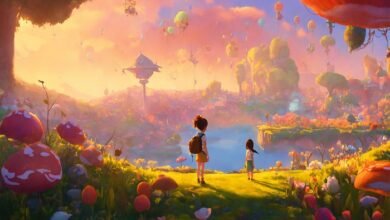Animal Movie Goggles: A Cinematic Journey Through the Eyes of Our Furry Friends

Introduction
Movies have the extraordinary ability to transport us to different worlds, allowing us to see life from various perspectives. One of the most delightful perspectives is through the eyes of animals. “Animal Movie Goggles” isn’t just about watching movies featuring animals; it’s about immersing oneself in their world, understanding their stories, and experiencing the emotional depth they bring to the screen. This blog post will take you on a journey through the fascinating genre of animal movies, highlighting classic films, animated masterpieces, and the significant role animals play in cinema.
The Charm of Animal Movies
Animal movies hold a special place in our hearts. They bring forth a sense of nostalgia, reminding us of childhood memories and the timeless bond between humans and animals. These movies often carry messages of loyalty, courage, and friendship, resonating with audiences of all ages.
A Historical Overview of Animal Films
Early Beginnings
The history of animal films dates back to the early 20th century. Silent films like “The Adventures of Kathlyn” (1913) introduced audiences to animal stars. These early films showcased the appeal of animals on screen, setting the stage for future productions.
Golden Age of Animal Films
The 1940s and 1950s were considered the golden age of animal films. Classics like “Lassie Come Home” (1943) and “Old Yeller” (1957) captured the hearts of millions, establishing animals as central characters in storytelling.
Animated Animal Masterpieces
Disney’s Magic Touch
Walt Disney revolutionized the animation industry with movies like “Bambi” (1942), “The Lion King” (1994), and “Zootopia” (2016). These films not only entertained but also imparted valuable life lessons, making them timeless classics.
Beyond Disney
Other studios have also contributed significantly to the genre. DreamWorks’ “Madagascar” series and Pixar’s “Finding Nemo” (2003) and “Ratatouille” (2007) brought unique narratives and endearing characters to the screen.
The Role of Animals in Film
Symbolism and Metaphor
Animals in movies often serve as symbols or metaphors, representing various human traits or societal issues. For instance, the fox in “The Fox and the Hound” (1981) symbolizes the challenges of friendship across societal divides.
Emotional Connection
Animals evoke strong emotional responses from audiences. Their innocence and purity can highlight human virtues and flaws, creating a deeper connection with the storyline.
Iconic Animal Characters
Lassie
Lassie, the heroic Rough Collie, became a household name with the release of “Lassie Come Home.” Lassie’s bravery and intelligence made her an enduring symbol of loyalty and courage.
Balto
The story of Balto, a sled dog who heroically delivered medicine to save children in Alaska, was immortalized in the 1995 animated film “Balto.” His tale of perseverance and bravery continues to inspire.
Documentaries: Real-Life Animal Stories
“March of the Penguins” (2005)
This documentary offers a breathtaking glimpse into the life of Emperor penguins in Antarctica. Narrated by Morgan Freeman, it showcases the penguins’ incredible journey and survival.
“Blackfish” (2013)
“Blackfish” is a powerful documentary that explores the dark side of keeping orcas in captivity. It brought significant attention to animal rights issues and sparked global conversations.
The Impact of Technology on Animal Films
CGI and Animation
Advancements in CGI have revolutionized the portrayal of animals in movies. Films like “The Jungle Book” (2016) and “The Lion King” (2019) used cutting-edge technology to create lifelike animal characters.
Motion Capture
Motion capture technology has enabled actors to bring animal characters to life in a more realistic manner. Andy Serkis’ portrayal of Caesar in the “Planet of the Apes” series is a prime example.
Animal Movies for All Ages
Family-Friendly Favorites
Movies like “Babe” (1995) and “Stuart Little” (1999) are perfect for family viewing. They offer heartwarming stories that appeal to both children and adults.
Mature Themes
Some animal movies tackle mature themes, making them suitable for older audiences. “Life of Pi” (2012) and “War Horse” (2011) delve into complex narratives and emotional journeys.
The Ethical Dimension: Animal Welfare in Filmmaking
Ensuring Animal Safety
The welfare of animal actors is a critical concern in filmmaking. Organizations like the American Humane Association monitor and certify that “no animals were harmed” during production.
Controversies and Challenges
Despite regulations, controversies have arisen regarding the treatment of animals on set. The documentary “The Cove” (2009) exposed the harsh realities of dolphin hunting, highlighting the need for stringent ethical standards.
The Future of Animal Movies
Virtual and Augmented Reality
Emerging technologies like virtual and augmented reality promise to revolutionize animal films. These technologies can offer immersive experiences, allowing viewers to interact with animal characters in new ways.
Continued Advocacy
As awareness about animal rights grows, filmmakers are increasingly focusing on ethical storytelling. Documentaries and films that highlight conservation efforts and animal welfare are likely to become more prevalent.
Conclusion
Animal movies have a unique charm that transcends generations. They offer a glimpse into the world of animals, allowing us to appreciate their beauty, intelligence, and emotional depth. From classic films to modern animations, these movies continue to captivate audiences with their heartwarming stories and powerful messages. As technology advances and ethical standards improve, the future of animal movies looks promising, ensuring that these beloved tales will continue to inspire and entertain for years to come.
FAQs
1. What makes animal movies so appealing? Animal movies are appealing because they evoke strong emotional responses, often featuring themes of loyalty, courage, and friendship that resonate with audiences of all ages.
2. Are animated animal movies suitable for adults? Yes, many animated animal movies, like “Zootopia” and “Finding Nemo,” include themes and humor that appeal to both children and adults.
3. How do filmmakers ensure the safety of animals on set? Organizations like the American Humane Association monitor and certify productions to ensure that no animals are harmed during filming.
4. What are some classic animal movies worth watching? Classics like “Lassie Come Home,” “Old Yeller,” and “Babe” are timeless favorites that have captured the hearts of audiences for generations.
5. How has technology impacted the portrayal of animals in movies? Advancements in CGI and motion capture technology have allowed for more realistic and lifelike portrayals of animals, enhancing the cinematic experience.





